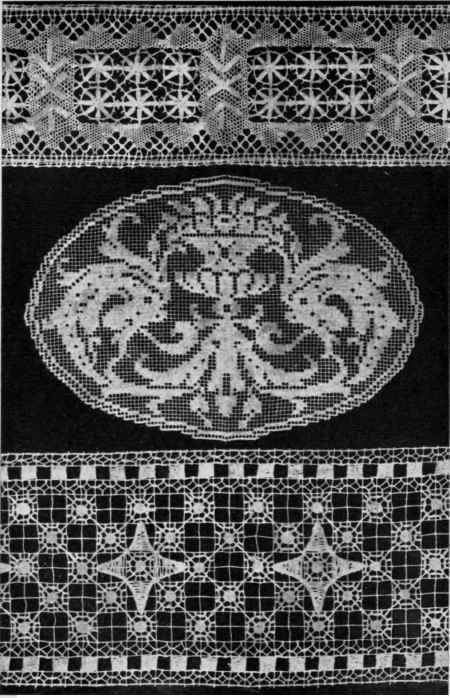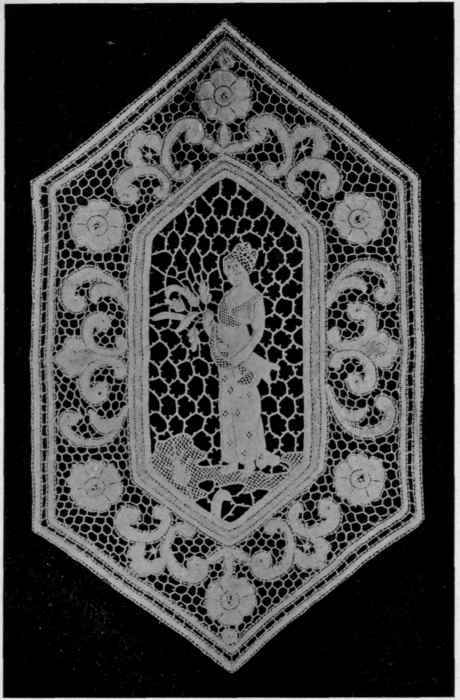XIV. Lace Curtains
Description
This section is from the book "Home Furnishing", by George Leland Hunter. Also available from Amazon: Home Furnishing.
XIV. Lace Curtains
THE lace curtains, spread and pillow cases that draped the bed of Marie Louise were of Alencon lace made entirely by hand - Napoleonic bees composed with the needle and applique inextricably into the substance of the pillow-made net. There have been other famous examples of draperies ornamented exclusively with point lace. But as a rule it is the coarser and firmer bobbin- or pillow-made hand laces that are employed for curtain work, and when they are mounted as insertions or edgings on net, the net is net that has been woven on the loom. Instead of net, etamine and fancy open-work or drawn-effect weaves are also employed.
Lace draperies like those just described are very properly classified as real lace curtains, while all others count as imitation lace curtains, but are none the less useful and beautiful because of it. As most of the real lace curtains used in the world were formerly made in France, while most of the embroidered lace curtains were made in Switzerland, the former were once almost universally called French lace curtains, the latter Swiss lace curtains. For convenience and clearness I retain these two terms in my classification of the varieties of lace curtains, as well as the term bobbinet, once employed to designate curtains with insertions and edgings of machine-woven lace. We have then as the basis of our classification:

In the middle, filet italien; above, Cluny; below, filet antique.
1. French or real lace curtains of which real lace made by hand with the needle or with the bobbin, forms an important part.
2. Bobbinet or imitation lace curtains with machine-woven insertions and edgings applique on machine-woven net.
3. Swiss or embroidered lace curtains.
4. Renaissance, lacet Arabian, Marie Antoinette, and braid lace curtains.
5. Nottingham lace curtains woven in one piece on the lace curtain machine.
6. Madras and Crete lace curtains.
7. Muslin curtains.
The principal varieties of hand-made lace used in curtain work are those illustrated in connection with this chapter: Venise, Flanders, Cluny, filet italien; filet antique. Flanders and Cluny are pillow-made laces, Venice is pointlace made with the needle, the two filet laces are made by darning or embroidering with the needle on square-meshed hand-made net. Real or thread Arabe lace is made on the pillow like Flanders lace, but has the patterns outlined by a cord. In combination with these laces, squares of hand-embroidered cut work in the form of broderie anglaise are often employed as well as squares of embroidered drawn work. Cut work and drawn work occupy an intermediate position between point and pillow laces, and woven laces. The point and pillow laces are made entirely by hand, the woven laces entirely on the machine, but the cut work and drawn work by hand on machine-woven cloth and etamine grounds. Often imitation laces, like those made on the schiffli embroidery machine, as well as machine-woven drawn-work effects, are combined with the real laces. To the ingenuity of the converter there is seemingly no limit.
The antithesis of French curtains is Notting-hams, so-called from the English city where the lace-curtain machine, as well as the imitation-lace machine, was invented. French curtains are made largely by hand and consist of many separate pieces sewn together. Nottingham curtains are made entirely by machine and in one piece. Formerly we imported all our machinewoven laces and lace curtains from England. The first lace curtain woven in America was made at Fordham, N. Y., in 1885. To-day the American makers of Nottinghams not only control the home market but in the style of their patterns and the interest of their product lead the English. One of the new effects is that of a double net border obtained by weaving at the edge of the curtain an extra width that is turned back and sewn down fast after it leaves the loom. Of course, the part that turns under the edging matches it exactly.

Point de venise panel framed in Flanders lace.
As the standard of American machine-woven curtains has risen, the makers have exerted every effort to get away from the word Nottingham, which, on account of the cheap and inferior curtains made for the mail-order houses, had fallen into disrepute. Some adhered to the old term of Scotch laces, others advocated American laces as a slogan for this American industry, and the name craft laces has also been introduced.
However, Nottinghams are Nottinghams, no matter how called, and while coarse of texture and obviously a cheap substitute, are comparatively durable because made in one piece, and have been especially favored by hotel proprietors who had to make a lace-curtain show at the minimum of expense, and with the least possible loss from wear and tear. Of course, Notting-hams, like other imitations, are apt to masquerade under real-lace names, especially in mailorder catalogues, and I have no doubt that farmers' wives in many remote parts of the country think that for $3 a pair they are getting the real thing. The Swiss as well as the real laces are also widely imitated on the lace curtain machine.
Just as Nottingham was the first center of the woven lace-curtain industry, so St. Gall stands preeminent for the manufacture of Swiss or embroidered curtains. But it is a house-to-house industry there, and the bonnaz machine is still run by foot in the cottage instead of by steam or electric power in the factory as here. In the rural districts of New England, fifty years ago, women used to employ their leisure at home profitably sewing together braid into straw hats. So still in St. Gall and vicinity, when outdoor work is not urgent, the Swiss families take to the embroidery machines.
Continue to:


